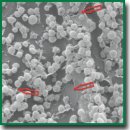
Lanthanoid Staining as a Fast Technology of Preparing Microbiological Specimens for Scanning Electron Microscopy
The aim of the investigation was to demonstrate advantages of lanthanoid staining as a novel super-fast technology of preparing microbiological specimens for scanning electron microscopy, and to ground the potentials of using this technology in practical microbiology.
Materials and Methods. Microbial cells (bacteria Acinetobacter baumannii, Corynebacterium diphtheriae, Klebsiella pneumoniae, Pseudomonas aeruginosa, Staphylococcus aureus, Streptococcus pneumoniae, and fungi Candida albicans), and Staphylococcus aureus-based bacterial biofilms were stained with the preparation based on neodymium chloride and visualized using scanning electron microscopy. Observations were carried out in the mode of low vacuum, images were captured in the mode of detecting back-scattered electrons using a short working section of 4.5–3.0 mm. Specimens were compared to the untreated microorganisms or microbial samples obtained by means of traditional specimen preparation with dehydration and sputtering a gold-platinum coating.
Results. The lanthanoid staining technology enabled visualization and evaluation of diagnostically relevant morphological structures of the following microbial cells: A. baumannii, C. diphtheriae, K. pneumoniae, P. aeruginosa, S. aureus, S. pneumoniae, C. albicans, including their relative position, shape, dimensions, presence of capsules and flagella, intracellular structures (polyphosphate inclusions, septum) as well as an extracellular bacterial matrix. The obtained images were characterized by a high contrast, which may be explained by the fact that lanthanoids are capable of providing a high density of electron back-scattering under the impact of the microscope electron beam, resulting in a great brightness of the biological object loci saturated with these elements.
Conclusion. Lanthanoid staining of microorganisms is a perspective method of specimen preparation for scanning electron microscopy, which opens the possibility of practical application of this method in diagnostic technologies of clinical microbiology.
- Chebotar I.V., Guryev E.L. Laboratory diagnostics of clinically significant microbial biofilms. Voprosy diagnostiki v pediatrii 2012; 4(4): 15–20.
- Priester J.H., Horst A.M., Van De Werfhorst L.C., Saleta J.L., Mertes L.A.K., Holden P.A. Enhanced visualization of microbial biofilms by staining and environmental scanning electron microscopy. J Microbiol Methods 2007; 68(3): 577–558, https://doi.org/10.1016/j.mimet.2006.10.018.
- Ensikat H.-J., Weigend M. Creating internal conductivity in dry biological SEM samples by a simple vapour treatment. J Microsc 2014; 256(3): 226–230, https://doi.org/10.1111/jmi.12177.
- Novikov I.A., Subbot A.M., Fedorov A.М., Griboedova I.G., Antonov E.N., Vakhrushev I.V. Supravital lanthanoid staining for scanning electron microscopy of biological objects. Geny i kletki 2015; 10(2): 90–96.
- Nakakoshi M., Nishioka H., Katayama E. New versatile staining reagents for biological transmission electron microscopy that substitute for uranyl acetate. J Electron Microsc (Tokyo) 2011; 60(6): 401–407, https://doi.org/10.1093/jmicro/dfr084.
- Pogorelov A.G., Chebotar I.V., Pogorelova V.N. Scanning electron microscopy of biofilms adherent to the inner catheter surface. Bull Exp Biol Med 2014; 157(5): 711–714, https://doi.org/10.1007/s10517-014-2648-0.
- Novikov I.A., Subbot A.M., Kiryushchenkova N.P., Nesterova T.V., Gabashvili A.N., Sitnikov A.V., Bursov A.I. Fast and easy method of lanthanoid staining for visualization of cellular ultrastructure and spatial arrangement. AIP Conference Proceedings 2016; 1748(1): 020009, https://doi.org/10.1063/1.4954343.
- Doggenweiler C.F., Frenk S. Staining properties of lanthanum on cell membranes. Proc Natl Acad Sci USA 1965; 53(2): 425–430, https://doi.org/10.1073/pnas.53.2.425.
- Shaklai M., Tavassoli M. Lanthanum as an electron microscopic stain. J Histochem Cytochem 1982; 30(12): 1325–1330, https://doi.org/10.1177/30.12.6185564.
- Evans C.H. Biochemistry of the lanthanides. New York: Springer Science & Business Media; 2013; 453 p.
- Chebotar I.V., Mayansky A.N., Mayansky N.A. Matrix of microbial biofilms. Klinicheskaya mikrobiologiya i antimikrobnaya khimioterapiya 2016; 18(1): 9–19.
- Rybal’chenko O.V., Bondarenko V.M., Dobritsa V.P. Atlas ul’trastruktury mikrobioty kishechnika cheloveka [Atlas of the ultrastructure of human gut microbiota]. Saint Petersburg: IITs VMA; 2008; 112 p.
- Donlan R.M., Costerton J.W. Biofilms: survival mechanisms of clinically relevant microorganisms. Clin Microbiol Rev 2002; 15(2): 167–193, https://doi.org/10.1128/cmr.15.2.167-193.2002.










